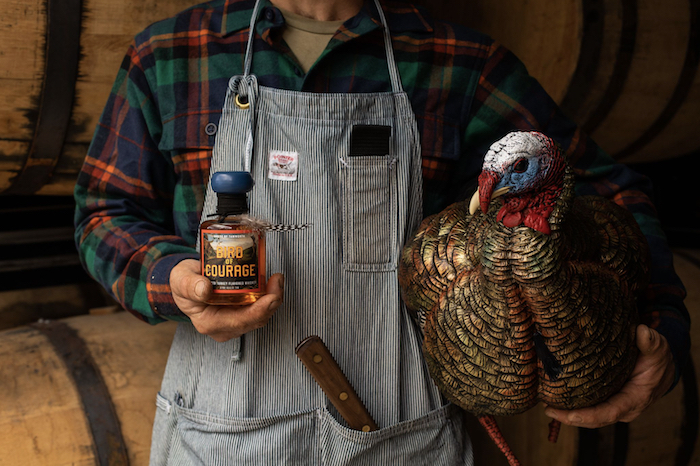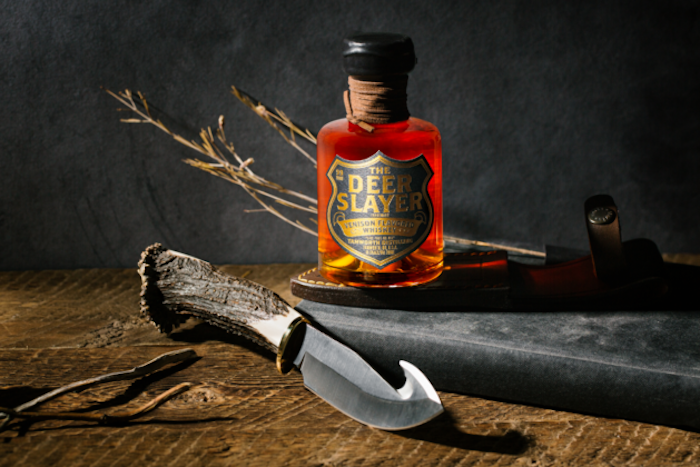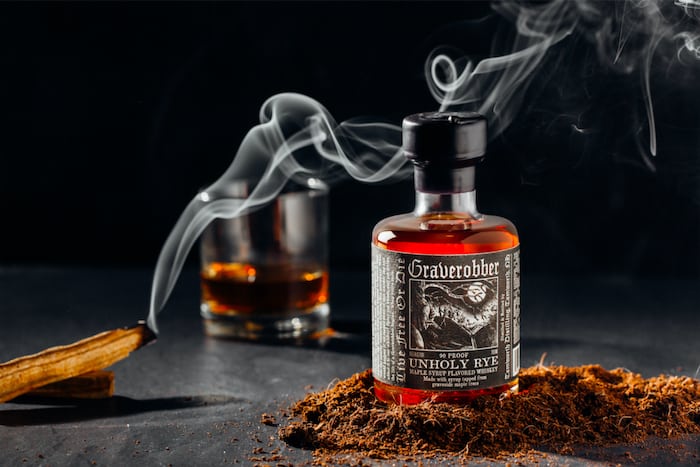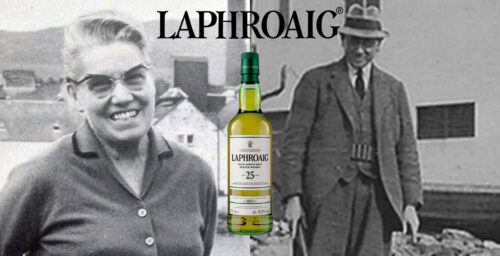For more than a century, Tamworth, New Hampshire has been a haven for artists, writers, thinkers and innovators – from inventors to poets to presidents.
An offbeat distilling company found this small town at the foot of the White Mountains to be the perfect place to do some innovating of their own.
Planting their flag in the heart of the historic New Hampshire village, the team at Tamworth Distilling takes cues from the New England pioneers of the past and operate the distillery in accordance with the land around them, not against it.
“What we take, we give back. And what we have, we give to you,” Founder Steven Grasse proclaimed of Tamworth Distilling’s creed. “We pull our inspiration and our ingredients from the environment that surrounds us. From start to finish, each spirit embodies our scratch-made ethos: local, house-milled grain, pure White Mountain water, herbs and botanicals from the woods and our garden, and local fruits and vegetables.”
These components give Tamworth Distilling the versatility to produce a variety of different products, and change batches with the seasons. And whiskey enthusiasts have taken notice of the many varied and offbeat spirits the brand has come up with.
The Whiskey Wash sat down with Grasse recently to hear the tale of Tamworth Distilling.

The Whiskey Wash: How did you come to be in the whiskey business?
Steven Grasse: “I have been in the whiskey business for 28 years now. We first worked with the Grant family on creating campaigns for Glenfiddich whisky, and we also created Hendricks Gin for them. When the Grants bought the Sailor Jerry Rum brand from us in 2008, I could finally afford to start my own distillery, so I did! I chose rural New Hampshire for three reasons:
- The best aquifer on the East Coast (great water makes great whiskey).
- I wanted to create something distinctly different with the “wilderness to bottle” process, hence the remote location.
- My family is from New Hampshire, going all the way back to 1632!”
TWW: What came first, the distillery or the kitchen?
Grasse: “They were conceived all at once. The idea for Tamworth from the beginning was to be a ‘test kitchen’ for all that is possible in the world of botanicals and spirits. We knew from the beginning that the distillery was going to have an extensive test kitchen that looks more like a meth lab — ha!”
TWW: Where does the inspiration come from, culinary wise, for some of Tamworth’s mash-ups?
Grasse: “The idea is to use what is natural from the surrounding environment. And, one of the things that is natural to our local mountain environment is wildlife. So you’ll see that represented in our Eau de Musc made with the castoreum sacs of locally trapped beaver, and with the Deerslayer Venison Whiskey, which is of course made with real venison farmed in New Hampshire, but also in the more botanically-focused spirits like our Apiary Gin, or the Tamworth Garden Pommeau made with apple cider and apple brandy.”

TWW: Tell us about the dual title of distiller and historian.
Grasse: “I think more than any other category, ‘spirits’ are about history and storytelling. So many great spirits brands have been around for hundreds of years, and many are still made by families. History and storytelling are such a huge part of our creative process when we come up with new brand ideas. And it’s not just the name of the brand or the label, we go deep into historical references and recipes when we come up with liquid ideas and profiles as well. We even use historical research to get interesting ingredients past the government TTB agents for approval.”
TWW: What is the secret to getting a full Thanksgiving meal distilled into one sip of booze?
Grasse: “The Bird of Courage whiskey was birthed from a barrel of 5-year-old Bottled in Bond Whiskey (12% rye, 81% corn, 7% malt) and steeped with a (mostly) historically accurate and quintessential New England Thanksgiving dinner. Our distiller Matt Power used ingredients present at the first thanksgiving 400 years ago such as flint corn (in which he used to make hand-ground corn bread) and even sourced local chestnuts (a feat as they were highly prevalent at the time, but entire east coast forests died in the 1930’s when they were wiped out by the chestnut blight). Apples and cranberries were sourced from Sugar Hill farm in Maine and kabocha squash from a New Day Farm in Conway, NH. Celery, flint corn, and parsley made its way into the bottle from Mountain Heartbeet Veggies in Effingham, NH., and apples and cranberries were foraged from local trees and wild cranberry plants walking distance from the distillery. We even picked fresh sage straight from the backyard garden at Tamworth Distilling.”
Tamworth Distiller Matt Power: “Like most good recipes, the devil is indeed in the details of using ingredients like these. The aromas of Thanksgiving go beyond just the ingredient combinations and really depend on how and when the ingredients are actually incorporated. We really tried to honor the classic recipe preparations to ensure we were starting with an authentic balance of aromas before infusion and distillation. This required enormous infusions of turkey and side dishes that all required distillation at a low temperature on a vacuum still to collect the aroma. An interesting discovery was that slightly well-done birds actually produce a more authentic turkey aroma in a distillate.”
TWW: What were the initial reactions to the spirits made from graveyard maples and distilled from venison pechuga style?
Grasse: “I find the reaction to House of Tamworth products to always be initially, ‘WTF!,’ and it purposefully must have that reaction built in because otherwise, it’s just another craft whiskey in a world of literally hundreds and hundreds coming out almost weekly. There are taboos that we aim to explore, whether it be harvesting sap from hallowed ground (Graverobber) or exploring carnivorous spirits. For example, when you see that pechuga translates to “breast” in English and is quite a traditionally special style of agave distillation, meant to be shared by close friends and family, you land on the modern American ritual of Thanksgiving turkey breast.”

TWW: Tell us about the natural ethos of Tamworth and the New England grit that comes along with that.
Grasse: “New England, and particularly New Hampshire, is a gritty land. Granite bedrock makes farming a very difficult task, and the cold climate further affects life. I have once heard it said that ‘if the United States were founded from West to East, no one would have settled in New England.’ That sounded disparaging at the time, but I personally have grown to love that concept. I think all New Englanders deep down take it as a challenge.”
TWW: What does New Hampshire have to offer whiskey makers that many other parts of the country don’t?
Grasse: “Climate is a huge factor … water another. We do have some beautiful water sources and the aging practices do not quite share the boisterous swings of humidity and heat of Kentucky. This plays a crucial role in spirit maturation. It is often noted that about 70 percent of the spirit’s character is attributed to the interaction with the wooden barrel it rests in. Our short and potent summers and cool climate would put climates closer to European spirits than Kentucky bourbon folk.”
TWW: Are there any experimental whiskies that were tried but scrapped that might be an interesting tidbit of trivia?
Grasse: “We made a Corpse Flower Durian Brandy, infused with durian fruit … the massive bumpy-skinned fruit grown in Thailand and Malaysia. Going back to that “WTF!” factor, we wanted to use durian fruit because it’s known for its odor reminiscent of rotting fish, smelly socks, stinky cheese, and even cadavers – we wanted to see how you could take something so objectively gross and make it enjoyable, let alone palatable. But, I wasn’t in love with the final product, and since durian (or corpse flowers, for that matter) aren’t grown in the White Mountains, the concept didn’t fulfill the promise or build the mythology of our distillery.”
TWW: What is something you’d like to try and make if given all the tools and resources needed to do so?
Grasse: “We just bought an additional 105 acres, and we are building new barrel houses and expanding our distillery, so, there isn’t much we can’t do.”
TWW: How can those outside of New England get their hands on some of these innovative products you’re coming up with?
Grasse: “Spirits are available for purchase through our sister store, Art in the Age in Philadelphia, and can be bought in store or online to be shipped anywhere in Pennsylvania. They are also available through Seelbachs.com for national shipment to more than 20 states.”









